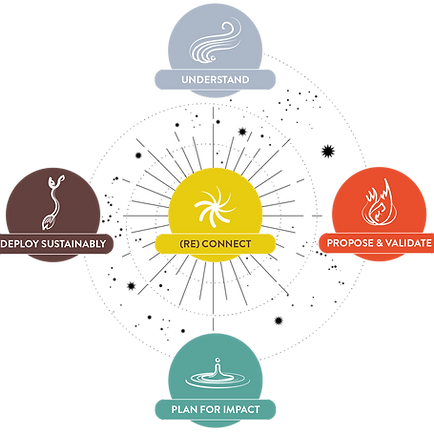Design for Conservation is a systemic approach to innovation
that draws from design methodologies
to find solutions to challenges that arise from the interaction
between people and the natural environment.
It understands that humans are just one species of a complex ecosystem that needs equilibrium to thrive.

D4C is an iterative process comprised of 5 core stages that can overlap and change order.
The best start for the D4C methodology is to follow this order: (re)connect, understand, propose and validate, plan for impact, and deploy sustainably. Repeat as necessary: learn, evolve, adapt, just like a natural system.
The strength and challenge of D4C is the (re)connection stage since it is central to all other activities.
Showing up as we really are, using empathy, staying vulnerable, and passionate about our project ensures that we embody the connection to an ecosystem that needs to be healthy for all of its parts to thrive. The D4C Mindsets complement the methodology allowing us to make the best of our personal skills in a collaborative process.
For each stage we have developed a set of tools, this list will keep growing, so stay tuned.

By re-connecting participants to themselves, their community, and their land through Empathy, D4C fosters the necessary mindsets for genuine, committed, creative and adaptive problem-solving.
TOOLS


Understanding environmental issues requires systems thinking, embracing ambiguity, and re-connecting to the sources. In order to do unbiased research, we have to unlearn our pre-conceptions and understand that the experts can be the people closest to the land, the species, the problem.
TOOLS


Getting inspiration from natural systems is one of the oldest approaches to problem-solving. Sourcing in slow, ancestral knowledge while using the latest technologies can yield highly innovative yet resilient ideas.
When prototyping rapidly and roughly, one can cut costs on testing, learning from early failure and iteration, evolving while doing, and adding definition to initial ideas.
TOOLS


Measuring impact is one of the most important tasks in environmental projects. Here, the Agile-to-Deep approach provides a realistic path allowing teams to use agile versions of impact measuring techniques that require less resources to conduct.
TOOLS


Deploying means further defining your ideas in order to bring them to effective action. This activity is comprised of tools that will help materialize your project. Whether for-profit or non-profit, most of these ideas start locally and small before scaling and replicating.
TOOLS

Still want to learn more?
Check out our FAQs, sign up to our newsletter or Join us!
